Agentic AI: Your New Digital Coworker

The conversation around artificial intelligence is evolving at a breakneck speed. Just as we’ve grown accustomed to the power of generative AI in creating text, images, and code, a new paradigm is emerging: Agentic AI. This isn’t just another incremental update; it’s a fundamental shift in how we interact with and leverage artificial intelligence.
From Assistant to Agent: What’s the Difference?
For the past few years, we’ve interacted with AI primarily through a command-and-response model. We ask a question, and a chatbot gives us an answer. We give a prompt, and a generative model creates an image. These are powerful tools, but they are fundamentally reactive.
Agentic AI, on the other hand, is proactive. Instead of simply responding to a single request, an AI agent can be given a complex goal and will then autonomously break that goal down into a series of tasks, execute those tasks, and adapt its approach based on the results. Think of it as the difference between a calculator and a financial analyst. A calculator can answer any equation you give it, but a financial analyst can be given the goal of “maximize my portfolio’s returns” and will then perform research, analyze data, and make a series of trades to achieve that goal.
The Dawn of the Digital Coworker
The implications of this shift are massive, particularly in the enterprise world. Imagine an AI agent tasked with planning a product launch. It could:
- Conduct market research: Analyze competitor products, identify target audiences, and research market trends.
- Develop a marketing plan: Outline a multi-channel marketing strategy, create ad copy and visuals, and schedule social media posts.
- Coordinate with teams: Send emails to the sales team, schedule meetings with the engineering team, and provide progress updates to leadership.
- Track success metrics: Monitor key performance indicators (KPIs) after the launch and adjust the marketing strategy accordingly.
This isn’t science fiction. While we are still in the early days of Agentic AI, the foundational technologies are already here. And as these systems become more sophisticated, they will become less like tools and more like digital coworkers, augmenting the capabilities of human teams and freeing them up to focus on more strategic, creative, and high-level tasks.
The Road Ahead: Challenges and Opportunities
Of course, the rise of Agentic AI also brings new challenges. Questions around security, ethics, and job displacement will need to be carefully considered. How do we ensure that these autonomous systems are aligned with our goals and values? How do we protect against malicious use? And how do we prepare the workforce for a future in which humans and AI agents work side-by-side?
These are not easy questions to answer, but they are essential ones to ask. The development of Agentic AI is not just a technological challenge; it’s a societal one.
The HarrisonAIX Perspective
At HarrisonAIX, we believe that Agentic AI represents one of the most significant technological shifts of our time. We are committed to developing and deploying these systems in a responsible and ethical manner, with a focus on augmenting human potential, not replacing it. The future of work is not a zero-sum game between humans and AI; it’s a collaborative one. And with Agentic AI, we are one step closer to that future.